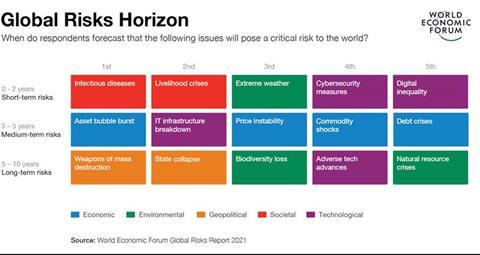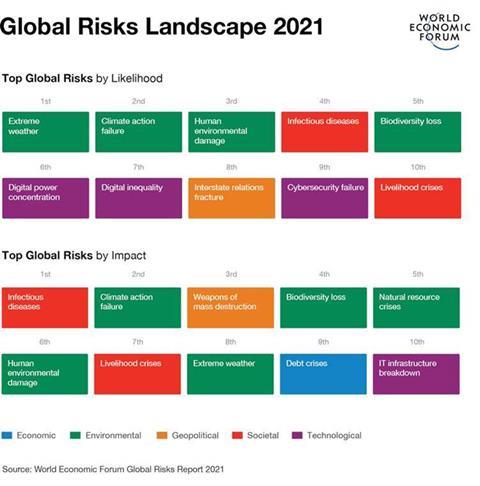In 2020, the world saw the catastrophic effects of ignoring long-term risks such as pandemics - WEF Global Risks Report 2021
The COVID-19 pandemic has not only claimed millions of lives, but it also widened long-standing health, economic and digital disparities.
Billions of caregivers, workers and students – especially minorities who were disadvantaged before the pandemic – are now at risk of missing pathways to the new and fairer societies that the recovery could unlock.
Speaking at the WEF Global Risks press conference, Børge Brende, president, World Economic Forum, described it as a liveihood crisis. ”Future growth has to be more inclusive and sustainable. If we don’t address this we will also see new risks when it comes to the fragmentation in society. That is one of the most important findings this year.”
Social cohesion at risk
“The pandemic in 2020 was a stress-test that shook the foundations of economies and societies worldwide. Rebuilding resilience to systemic shocks will require significant funding, international cooperation and greater social cohesion,” said Lee Hyung-hee, president, Social Value Committee, SK.
According to the World Economic Forum’s Global Risks Report 2021, these developments may further impede the global cooperation needed to address long-term challenges such as environmental degradation.
When it comes to technology access and digital skills, the gap between the “haves” and the “have nots” risks widening and challenging social cohesion. This will particularly affect young people worldwide, as this group faces its second global crisis in a generation.
Financial, digital and reputational pressures resulting from COVID-19 also threaten to leave behind many companies and their workforces in the markets of the future.
Meanwhile, an increasingly tense and fragile geopolitical outlook will also hinder the global recovery if mid-sized powers lack a seat at the global table.

Time to act, not react
Once again, environmental risks dominate by impact and likelihood, looking ahead towards the next decade. Societal fractures, uncertainty and anxiety will make it more difficult to achieve the coordination needed to address the planet’s continued degradation.
For the first time, the report also rates risks according to when respondents perceive they will pose a critical threat to the world.
- Clear and present dangers (0-2 years) reveal concern about lives and livelihoods – among them infectious diseases, employment crises, digital inequality and youth disillusionment.
- In the medium-term (3-5 years), respondents believe the world will be threatened by knock-on economic and technological risks, which may take several years to materialise – such as asset bubble bursts, IT infrastructure breakdown, price instability and debt crises.
- Existential threats (5-10 years) – weapons of mass destruction, state collapse, biodiversity loss and adverse technological advances – dominate long-term concerns.
“In 2020, the risk of a global pandemic became reality, something this report has been highlighting since 2006. We know how difficult it is for governments, business and other stakeholders to address such long-term risks, but the lesson here is for all of us to recognise that ignoring them doesn’t make them less likely to happen. As governments, businesses and societies begin to emerge from the pandemic, they must now urgently shape new economic and social systems that improve our collective resilience and capacity to respond to shocks while reducing inequality, improving health and protecting the planet,” said Saadia Zahidi, managing director at the World Economic Forum.
The report also reflects on the responses to COVID-19, drawing lessons designed to bolster global resilience. These lessons include formulating analytical frameworks, fostering risk champions, building trust through clear and consistent communication, and creating new forms of partnership.
The key risks outlined in the report are complemented with recommendations to help countries, businesses, and the international community to act, rather than react, in the face of cross-cutting risks.
The report closes with an overview of “frontier risks” – nine high-impact, low-probability events drawn from expert foresight exercises – including geomagnetic disruption, accidental wars and exploitation of brain-machine interfaces.

Businesses must improve resilience
“The acceleration of the digital transformation promises large benefits, such as for example the creation of almost 100 million new jobs by 2025. At the same time however, digitalisation may displace some 85 million jobs, and since 60% of adults still lack basic digital skills the risk is the deepening of existing inequalities,” said Peter Giger, group chief risk officer, Zurich Insurance Group.
“The biggest long-term risk remains a failure to act on climate change,” he added. ”There is no vaccine against climate risks, so post-pandemic recovery plans must focus on growth aligning with sustainability agendas to build back better.”
“Economic and societal fallout from COVID-19 will profoundly impact the way organisations interact with clients and colleagues long after any vaccine rollout. As businesses transform their workplaces, new vulnerabilities are emerging,” said Carolina Klint, Risk Management leader, Continental Europe, Marsh.
”Rapid digitalisation is exponentially increasing cyber exposures, supply chain disruption is radically altering business models, and a rise in serious health issues has accompanied employees’ shift to remote working. Every business will need to strengthen and constantly review their risk mitigation strategies if they are to improve their resilience to future shocks.”
“Group Resilience will also hinge on the continued growth in connectivity worldwide, as we know that economies that digitised early performed relatively better in 2020,” added SK’s Lee Hyung-hee. ”If the continued deployment of 5G and AI is to emerge as an engine of growth, however, we must urgently bridge digital divides and address ethical risks.”
Downloads
WEF_The_Global_Risks_Report_2021
PDF, Size 9.1 mb







No comments yet